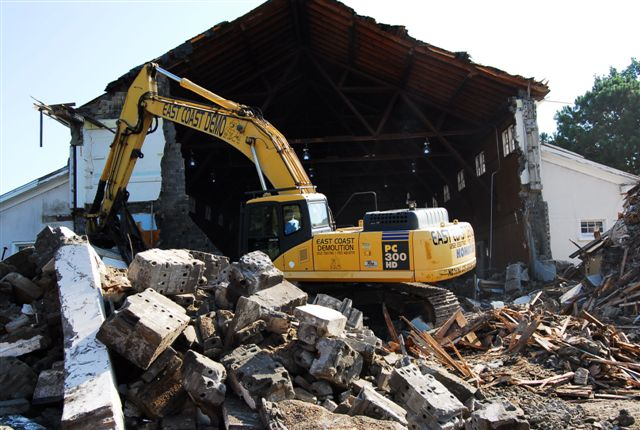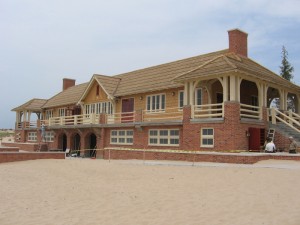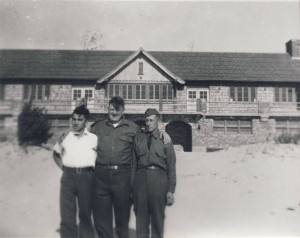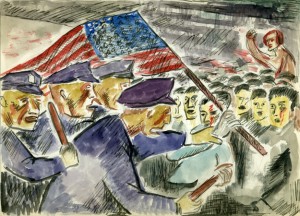In the film, “Inequality for All,” economist and Living New Deal Advisor Robert Reich explains the problem—Americans are working harder and earning less. As the government shutdown attests, we’re far from a solution. During the New Deal, our leaders endeavored to provide jobs, health, education, and art for all Americans while building the foundation for prosperity. What the New Deal achieved then shows the way forward now. The Living New Deal is spreading the word. We’re reaching thousands of people through our website, talks, tours, and publications. A generous donor will match each dollar donated through the end of the year—up to $50,000. Won’t you help? Please make your tax-deductible donation today.
- Home
- /
- News, Articles & Newsletters /
- The Fireside
- /
- Fall 2013
Fall 2013
Communities Fight to Save U.S. Post Offices and New Deal Art
Coast to coast, from the Bronx and Chelsea in New York City to Venice, La Jolla, Ukiah, Redlands, and Berkeley in California, the Postal Service has decided that it will sell historic downtown post offices without looking at alternatives.
Hundreds of post offices are up for sale or lease, and the list is growing. Of the 56 U.S. post office buildings currently for sale, six are on the National Register of Historic Places and more may be eligible.
The Berkeley-based National Post Office Collaborate has filed suit in federal court to stop the sale of the Renaissance-style Stamford, Connecticut, Post Office and is prepared to do the same for Berkeley and La Jolla, California and the monumental post office in the Bronx, renowned for its thirteen murals by New Deal artist Ben Shahn.

Stamford Post Office, Courtesy Save the Post Office
Stamford, Connecticut’s Renaissance-style post office may be sold and largely demolished for luxury condos.
After months of public protest and formal appeals by the city, on July 18 Postal Service officials announced that, despite near-unanimous community opposition, it would sell Berkeley, California’s historic post office, citing “dire financial circumstances facing the Postal Service.”
The announcement provoked a month-long encampment in downtown Berkeley to defend the post office and the New Deal artworks it contains.
Berkeley Planning Commissioners voted unanimously on a measure restricting the use of historic buildings in the civic center, including the post office, to community-serving purposes. The California State Legislature passed a measure urging the U.S. Congress to stop the sale of historic post offices and undo the constraints that Congress imposed in 2006 requiring the Postal Service to pre-pay 75-years of health benefits for Postal Service employees—part of the conservative agenda to privatize the U.S. Postal Service by pushing it into bankruptcy.
Two weeks ago, the Downtown Berkeley Post Office was listed for sale. CBRE holds an exclusive contract with the U.S. Postal Service to sell and lease the post office properties, valued at billions of dollars. The USPS-CBRE relationship is the subject of an explosive exposè by investigative reporter Peter Byrne that found that CBRE — chaired and largely owned by Senator Dianne Feinstein’s husband, Richard Blum — has consistently sold valuable public properties to its associates at prices well below market rates.
The Collaborate is urging an investigation by the USPS Office of Inspector General David Williams. Contributions to defray substantial legal expenses can be made to NPOC, PO Box 1234, Berkeley, CA 94701.
Inequality for All
Robert Reich, the ubiquitous economist and Living New Deal Advisory Board member, is taking his message of economic inequality to the masses. Reich, a UC Berkeley professor and a prolific author, is also an accidental movie star. His documentary “Inequality for All” sounds the alarm about the country’s widening economic gap– its causes, implications, and what we can do about it.
“Inequality for All” opened on September 27 and is showing in theaters nationwide. Like Al Gore’s Oscar-winning film about global warming, Reich’s film offers an engaging lecture. This time the “inconvenient truth” is the evaporating prosperity of the American middle class. Reich answers why since the 1980s Americans that have jobs are working more and earning less.
Reich was U.S. Labor Secretary in the Clinton administration, during which time unemployment in the U.S. dropped to the lowest level in thirty years.
Reich and Bill Clinton met when they were Rhodes scholars at Oxford University. Today Reich is a road warrior, traveling nearly non-stop and drawing crowds and media attention wherever “Inequality for All” is playing.
The film created a buzz when it premiered at the star-studded Sundance Film Festival earlier this year. Since then, Reich has left no media stone unturned. He writes a daily blog, maintains a popular website, uploads his talks to YouTube, and has a vast Facebook following. He has recently published op-eds in The New York Times
and Salon.
“Inequality for All” has been reviewed in such divergent publications as the Huffington Post, the Hollywood Reporter, and the Salt Lake City Tribune. Reich has appeared on the PBS News Hour, CNN, The Daily Show, Bill Moyers, and Democracy Now. You can watch him in action on The Colbert Report, for example. Conservative talk show hosts like Fox News’s Bill O’Reilly regularly rail against Reich, but refuse to debate him.
Either way, Reich is reaching the choir and beyond. His message: Inequality is bad for everyone. Let’s change it.
For more information: inequalityforall.com
Learning to See
Historic preservationists have to have two sets of eyes: One set that sees clear-sightedly into the past and one that sees into the future. People that don’t have this duel vision look at old buildings and see just that. But those that do can’t help but visualize what that place looked like in its heyday, who frequented it, what went on there, how that building influenced the lives around it.
Some people want to tear down an old structure to make room for the new. Others foresee its preservation and reuse. Just such a tug-of-war recently played out in Roanoke Island, North Carolina. On one side, the Dare County Board of Education and its supporters saw a WPA-era gymnasium, built in 1938, as old and in the way of a needed expansion of the local elementary school. They wanted the gym torn down. On the other side, local preservationists wanted TO see the WPA gym preserved.
Preservationists came up with a solution that would give the school board room to expand without demolishing the old gym. Yet, the tug of war continued.
The question is why? Is it a power struggle–the “fuddy duddies” versus the forward thinkers? Is it the belief that anything new is better than something old?
Far more is stake than just an old gym. Communities around the country find themselves embroiled in similar conflicts. One answer we’ve formulated at the Manteo Preservation Trust is that people need to learn to see more than they’re seeing. As preservationists it’s our job to teach them how.
In the heat of the tug, there’s no time to tell the story of what a place once was, why its walls contain more than brick or wood or cement, what the building meant to people. This kind of seeing can best be taught in neutral times. As historians and preservationists we have to teach people how to see past the exterior and into the heart and soul of a place.
—Beth Storie is a member of the board of directors of the Manteo Preservation Trust in Roanoke Island, North Carolina and of North Carolina Coastal Land Trust.
A CCC Jewel Restored on Lake Michigan
When the state of Michigan was given 3,500 acres of logged-over land on the shores of Lake Michigan in 1926, it was hoped that the nearby Big Sable Point Lighthouse might become a beacon not only for ships but for tourists as well. Back then, the land was reachable only by foot or boat, and the state lacked money to develop it as a park. That changed in 1933 with the advent of the New Deal.
The Pere-Marquette S-2 CCC Camp quickly went up on the state’s land and the young men of the Michigan Civilian Conservation Corps began shaping the sand dunes, beaches, and skid trails into the Ludington State Park.
Under the direction of the National Park Service, they built roads, retaining walls, campgrounds, hiking trails, the park’s headquarters, and the Lake Michigan Beach House. Designed by renowned NPS architect Ralph B. Herrick, the one-of-a-kind, arts-and-crafts-style Beach House is regarded as the crown jewel of Michigan’s park system.
The CCC Boys hand dug the foundation, water system, and septic field for the 116-foot building. A deal struck with the Morton Salt Company in the nearby town of Ludington had the CCC tear down a derelict salt mill in exchange for salvaged materials. The Corps carefully reclaimed the rust- colored bricks and massive, rough-sawn, white pine beams to build the two-story Beach House.
Time and weather took their toll on the 1935 landmark. In 1999 the state undertook a $1.6 million restoration of the iconic building. Reconstruction began in 2012. The interior was gutted and a new wood shingle roof was installed. The exterior— sandblasted over decades by the fierce Lake Michigan winds—was refurbished with new bricks and mortar carefully chosen to match the original.
The upper floor, which had been subdivided, was restored to one large room. The original stone fireplace still occupies the south end. Doors on three sides lead to a veranda and patio. In place of the original changing rooms, there’s now a café and gift shop. New signage along the beach walk interprets the geology of Lake Michigan and some of the largest freshwater sand dunes in the world.
Ludington State Park has grown to 5,300 acres and receives nearly a million visitors annually. The Lake Michigan Beach House was added to the National Register of Historic Places this year. A display honoring the men of the CCC who built the state park soon will be installed in the beautiful Beach House they constructed.
With thanks to Alan Wernette, State Park Interpreter,
Ludington State Park
The Moral Equivalent: Redefining the Warrior Spirit
Our National Forests, no less than their infrastructure, are a mess after decades of neglect. The Rim Fire at Yosemite National Park last summer made that abundantly clear as it burned over 400 square miles of the Sierra Nevada flank — the largest wildfire in California history — after similar monster wildfires decimated Colorado’s Front Range.
During this fiery summer, Columbia University professor Mark Mazower published an essay in the Financial Times titled “The West Needs A Replacement of the Warrior Spirit“. Mazower seemed to rue the loss of the civic virtue and egalitarian camaraderie that, he asserts, linked warfare in the 20th century to the kind of welfare typified by Roosevelt’s New Deal.
The problem of how a nation sustains political unity in the absence of an external enemy also vexed the American psychologist and philosopher William James, especially once advanced weaponry made it possible for war to erase entire cities, nations, and ultimately the planet. James’s answer was more definitive than Mazower’s rhetorical question “where is the heroism, or the warrior spirit, in wielding a joystick?”
In his influential 1910 essay “The Moral Equivalent of War,” based on a talk he delivered at Stanford University, James recommended that in place of military conscription the U.S. should adopt a “conscription of the whole youthful population to form for a certain number of years a part of the army enlisted against Nature.”
Many feel that James’s essay played a role in FDR’s advocacy for and creation of the Civilian Conservation Corps in 1933. Less adversarial in its approach to nature than James, the C’s were known as Roosevelt’s Tree Army, not only for the forests and wind breaks they planted but for the extent to which three million young men manually managed existing stands of trees; repaired and stocked streams; countered flooding and erosion; constructed fire look outs, and served on fire crews.
Roosevelt and others in his administration often likened the New Deal to a war against want, a battle that constructed rather than destroyed communities and land while it built the self respect of the men and women it employed.
When I read the accounts of CCC vets, I am as struck by the pride and gratitude they carried throughout their lives as a result of their service as I am by their superb craftsmanship in our national and state parks.
That was the constructive surrogate for the warrior spirit of the past that our forests — and our youth — cry out for today.
Exhibition Celebrates WPA Artist Leon Bibel
“Art, Activism, and the WPA,” on exhibit at the University of Richmond Museums in Virginia, focuses on the passionate social engagement of New Deal artist Leon Bibel (1913-1995), whose work depicts “the social ills of racism, poverty, unemployment, and war; the necessity of protest; and the shared humanity of the common worker.”
Art on display includes a painting called “The Lynching,” the lithograph “Unemployed Marchers,” and many scenes of the Spanish Civil War.
Curator Phyllis Wrynn of the Park Slope Gallery in Brooklyn, who knew the artist personally, says Bibel “saved everything.” The exhibition includes documents, photographs, and sketches from Bibel’s 9-year stint working for the Federal Art Project of the WPA. Bibel worked as an assistant to Bernard Zakheim in San Francisco and then moved to New York City and joined the FAP there. The financial security that came with this government job and the sense of being involved in a vital art movement made the WPA years the happiest of his life. According to Wrynn, Bibel told her “It was a miracle to be paid to do what he loved,” and spoke of “the camaraderie among the artists who supported each other’s efforts in many ways, eagerly sharing techniques, supplies, and information.”
Wrynn made a short film about Bibel’s life and work to accompany the exhibit. (See it on-line at https://parkslopegallery.com/html/leon-bibel-movie.html.) Documentary footage, photos, Bibel’s paintings and drawings, and his on-camera reminiscences give a vivid shapshot of the art world in the 1930s. The New Deal art projects and the Artist’s Union are prominently featured.
Like the Bernard Zakheim exhibition held in San Francisco two years ago, this show foregrounds the artist’s WPA connection. Although many artists of that generation spent some time working for the Federal Art Project, this has often been treated as a tangential or even embarrassing part of their careers. The Living New Deal is delighted to see the WPA finally getting credit for nurturing artists’ careers, sponsoring memorable works, and contributing significantly to the development of 20th century American art.
Information about the exhibition and related programs is at https://museums.richmond.edu/exhibitions/lora-robins-gallery/Leon-Bibel.html.
Book Review
Archie Green: The Making of a Working-Class Hero
By Sean Burns
University of Illinois Press, 2011

Like many others, I made the pilgrimage to Casilli Street in San Francisco to interview the American folklorist Archie Green. As usual, he was sitting in the front window of his home watching the street.
Although we were a generation apart, there were several parallels in our lives – moving to Los Angeles in our youth, graduating from UC Berkeley, love of the outdoors, working as a union carpenter, an admiration for the New Deal.
Archie personified my ideal of the worker/intellectual. His involvement with the New Deal began with a National Youth Administration (NYA) job while a student at UC Berkeley. Upon graduation, he enlisted in the Civilian Conservation Corps (CCC)—rare for someone with a college education—and worked as a firefighter and road builder along the Klamath River in Northern California. Soon after he began working as a shipwright in San Francisco and was drawn into the city’s lively cultural scene, including the favorite watering hole of New Deal artists—the Black Cat Bar in North Beach.
Later Archie developed an interest in labor folklore and began documenting the culture and traditions of American workers. He gathered and commented upon the speech, stories, songs, emblems, rituals, art, artifacts, memorials, and landmarks that constitute “laborlore.” He not only collected material from laborers but also encouraged workers to preserve their own stories.
Documenting and honoring working-class culture became Archie’s focus for the remainder of his life. After many years lobbying Congress, Archie succeeded in getting a bill passed that established the American Folklife Center within the Library of Congress to preserve, support, revitalize, and disseminate American folk traditions. The Center’s archive, which includes Archie’s work, is open to researchers and the general public.
Author Sean Burns spent considerably more time with Archie that I did. His interviews and research into Archie’s remarkable life for this book make it more than simply a biography. Burns himself calls it “a discussion of Green’s political and intellectual formation”–what pushed Green into a life of activism. It is a tribute to a man who was deeply committed to cultural pluralism and a path of work, scholarship, and action.












